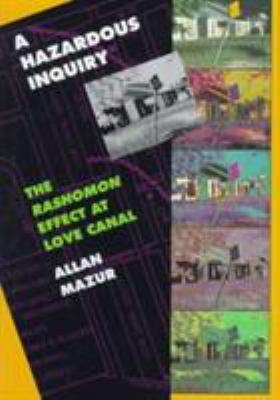
A hazardous inquiry : the Rashomon effect at Love Canal
Available Copies by Location
| Location | |
|---|---|
| Victoria | Available |
Browse Related Items
- ISBN: 0674748336
-
Physical Description
print
xii, 255 pages : illustrations, map ; 25 cm - Publisher Cambridge, Mass. : Harvard University Press, 1998.
Content descriptions
| Bibliography, etc. Note: | Includes bibliographical references (pages 237-249) and index. |
Additional Information

A Hazardous Inquiry : The Rashomon Effect at Love Canal
Click an element below to view details:
Summary
A Hazardous Inquiry : The Rashomon Effect at Love Canal
Love Canal. We hear these words and quickly recoil, remembering a community poisoned by toxic waste. Twenty years after the incident, Allan Mazur reexamines the circumstances that made this upstate New York neighborhood synonymous with ecological catastrophe and triggered federal "Superfund" legislation to clean up the nation's thousands of hazardous waste sites. But is there only one true story of Love Canal? Borrowing the multi-viewpoint technique of the classic Japanese film Rashomon , Mazur's book reveals that there are many--often conflicting versions of what occurred at Love Canal. Hooker Chemical Company, which deposited the toxic wastes, explains why it subsequently donated the dump as the site for a new school. Lois Gibbs, whose son attended the school, tells of organizing the community to fight both the chemical threat and the uncaring state bureaucracy. Then there is the story of David Axelrod, New York's embattled commissioner of health, at odds with the homeowners over their assessment of the hazards and the proper extent of the state's response. We also hear from Michael Brown, the young reporter who developed the story in the Niagara Gazette and eventually brought the problem of toxic waste to national attention. If A Hazardous Inquiry succeeded only in making us understand why one version of the events at Love Canal gained precedence over all others, it would be invaluable to policy makers, journalists, scientists, environmentalists, lawyers, and to citizens caught up in technical controversies that get played out (for better or worse) in the public arena. But the book moves beyond that to evaluate and reconcile the conflicting accounts of Love Canal, giving us a fuller, if more complex, picture than ever before. Through gripping personal tales, A Hazardous Inquiry tells how politics and journalism and epidemiology sometimes mesh, but often clash, when confronting a potential community disaster.


